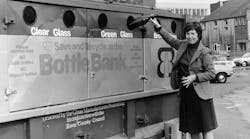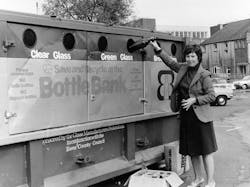Several years ago, an e-mail pointing out many of the ways older folks were much better stewards of the environment than the millennials who think of themselves as superior in this respect was going around. Some of the examples cited were the use of returnable glass bottles, the re-use of paper grocery bags as book covers (yes, I did that in junior high school!), neighborhood shopping that didn’t require our grandparents to start their more-than-likely only car, cloth diapers that didn’t end up in the landfill after one use, push mowers, and the use of clotheslines instead of gas or electric dryers. Additionally, our parents and grandparents certainly didn’t buy their single serving of drinking water in plastic bottles!
Many believe the “green movement” started with the publication of Rachel Carson’s book “Silent Spring” in 1962. Although her focus was on the harmful effects on both natural ecosystems and human health of synthetic pesticides—particularly DDT, which was banned for agricultural use as a result of the book—the underlying message was that humans were having a detrimental effect on the natural world. Many believe, I think correctly, that the creation of the Environmental Protection Agency (EPA) resulted from her work. In any event, we Americans have become much more eco-minded in the 50 or so years since: We have green-building rating systems, ENERGY STAR-labeled appliances, low-volatile-organic-compound paints, and phosphate-free soaps and detergents, to name just a few examples, which most of us take for granted.
In what other ways were our parents and grandparents more eco-friendly? According to the EPA, each American today generates an average of 4.4 pounds of garbage per day (and that’s just household waste, not industrial or commercial). Although I don’t have statistics as to how much our parents and grandparents threw away, I do know that “disposable” wasn’t part of their vocabulary—for either things or income! Additionally, we waste more than 200 pounds of food per person per year. With the U.S. Department of Agriculture saying the average American eats 4.7 pounds of food per day, that means we throw away enough to feed all of us for a month-and-a-half.
Today, we pride ourselves on our hybrid and electric cars. But, believe it or not, our great-grandparents beat us to the punch. The first electric car was the 1891 Morrison. It delivered a whopping 4 hp, could carry six to 12 passengers at a breathtaking 20 mph, and could go 50 miles between charges. There were six other electric cars built prior to 1910; one of them—the 1906 Krieger—had regenerative braking, just like my Prius.
I hope we never again have a need for war gardens (also called victory gardens), but, WWI and WWII notwithstanding, our grandparents did grow a lot of their own fruits, vegetable, and herbs. What they didn’t use, they shared, froze, or canned for later.
So, millennials, cut your parents and grandparents some slack. They really didn’t do such a bad job of protecting the environment. They just didn’t realize that is what they were doing!










